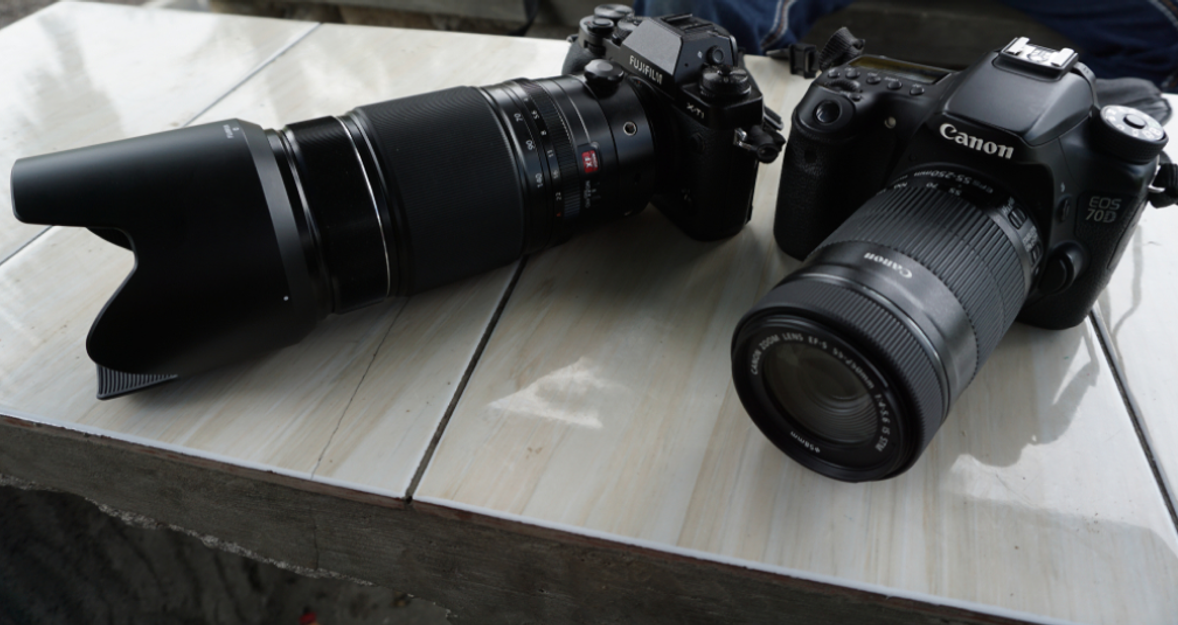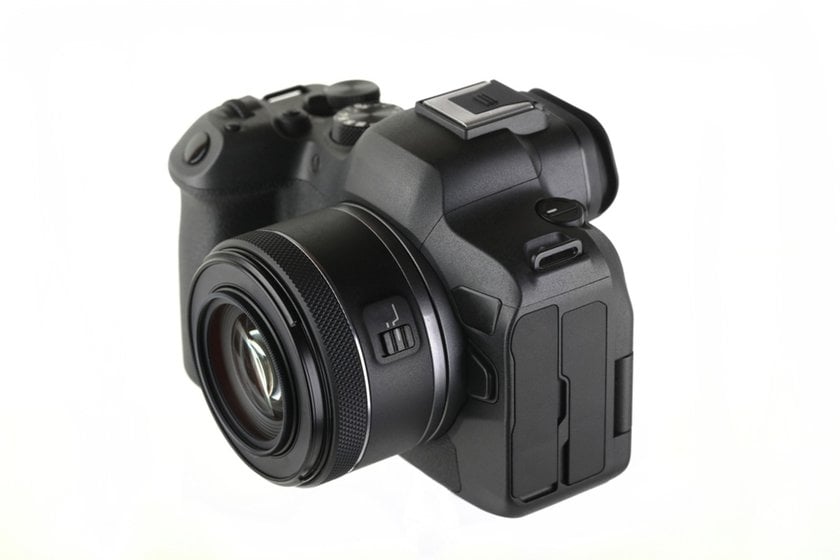Mirrorless vs DSLR Cameras: Which One Should You Choose?
Last Updated on September 29, 2025

Deciding between DSLR vs mirrorless camera? Understanding the strengths and trade-offs can save frustration and money.
Choosing between a mirrorless and a DSLR isn’t always simple, but it helps to think of them as different tools. A DSLR gives you durability, long battery life, and access to decades of reliable lenses, while a mirrorless camera offers lighter builds, quicker autofocus, and the best video features. It really comes down to whether you value portability and modern previews or the rugged feel and lasting power of a classic setup. In the end, the best camera is the one you enjoy picking up and shooting with every time.
This guide strips away the buzzwords and gives straightforward, useful advice so you can spend less time researching and more time shooting.
Understanding the Basics: Mirrorless vs DSLR Cameras
A mirrorless camera sends light straight from the lens to the image sensor, showing the image either on the rear screen or an electronic viewfinder (EVF). Because there is no flipping mirror and separate optical viewfinder, mirrorless designs can be shallower and pack modern on-sensor autofocus systems that track subjects across nearly the entire frame.

A DSLR (digital single-lens reflex) uses a mirror box that reflects incoming light into an optical viewfinder. When the shutter fires, that mirror flips up, and the light hits the image sensor. Tradition and rugged ergonomics define many DSLRs, including robust battery compartments, deep handgrips, and long-lived lens lineups.
So, what is the difference between them? The main design distinction is the presence or absence of a mechanical mirror. This affects the type of viewfinder, the way autofocus systems are built, and how much internal space is available for electronics and stabilization. These mechanical differences ripple through other aspects as well, influencing shooting speed, battery life, and overall handling.
An Array of Professional Photo Filters to Elevate Your Images
DiscoverMirrorless Camera vs DSLR: In-Depth Comparison
Picking a DSLR or mirrorless camera is a common headache for photographers; the right one depends on your shooting style and priorities.
1. Size and Weight
Mirrorless bodies often shave centimeters and hundreds of grams off DSLR alternatives because the mirror box is gone. For example, a full-frame mirrorless body like the Sony A7-series feels noticeably smaller and lighter in a jacket pocket compared to a full-frame DSLR such as the Canon 5D-class with a battery grip.
This compactness is a real advantage for travel, street, and event photographers who carry their gear for long periods.
A smaller camera body doesn’t always mean you’ll carry less weight. Even on a compact mirrorless body, bright primes and long stabilized telephotos can be surprisingly heavy. Match a small camera with a lightweight lens (a 35mm f/1.8, for example) and you’ve got a great kit for street shots, hikes, or casual days out.
2. Lenses: Compatibility and Versatility
Lens ecosystems still matter. DSLRs carry decades of mounted glass, and Canon EF and Nikon F lenses are common and often affordable on the used market.  Mirrorless systems like Sony E, Canon RF, and Nikon Z are newer but growing fast, and their short flange-distance designs let makers produce smaller, often sharper optics.
Mirrorless systems like Sony E, Canon RF, and Nikon Z are newer but growing fast, and their short flange-distance designs let makers produce smaller, often sharper optics.
Adapters have become a practical bridge: Canon’s EF lenses work on RF bodies via an official adapter with full electronic control, and third-party adapters allow many EF and F lenses to function on modern mirrorless mounts with differing degrees of autofocus support. Using legacy glass on mirrorless bodies is a common strategy to leverage existing optics while getting modern focusing benefits.
If you’re evaluating Canon versus Nikon in particular, how their lens lineups, brand support, and future options compare, this Nikon vs Canon Cameras guide digs into what sets the two apart.
3. Viewfinders: Optical vs Electronic
DSLR versus mirrorless viewfinders: understanding the differences can help you choose the right camera for your photography needs. Optical viewfinders (OVF) in DSLRs present a direct, lag-free view of the scene and are favored in bright sunlight and fast-moving situations where seeing the world without electronic processing matters. They provide a natural, real-time view and are excellent for tracking action, composing shots quickly, and conserving battery life.
Electronic viewfinders (EVF) in mirrorless cameras, on the other hand, offer a live preview of exposure, white balance, and depth of field before the shot is taken, which is especially helpful under tricky lighting conditions. At a wedding with tricky lighting, an EVF lets you instantly see if the highlights are blowing out or how the skin tones will look, while an OVF usually means taking a few test shots and relying on experience to get it right.
Additional points to consider:
EVFs can display focus peaking, zebras for overexposure, and histogram overlays, which are invaluable for precise control.
OVFs have no lag or refresh issues, which some sports or wildlife photographers prefer for high-speed tracking.
EVFs allow previewing creative settings like picture profiles, filters, or real-time HDR effects before pressing the shutter.
Choosing between the two often depends on shooting style, lighting conditions, and whether real-time exposure feedback is more valuable than the natural optical view. A hybrid workflow is common: many pros use the EVF for controlled shoots and switch to OVF-style behavior (or larger-grip DSLRs) when they need long battery life and immediate, always-on viewing without electronic artifacts.
4. Autofocus Performance
 DSLR or mirrorless camera autofocus systems are essential features that determine how quickly and accurately a camera can focus on subjects, impacting overall image quality. Modern mirrorless autofocus systems rely on on-sensor phase detection and machine-learning subject detection, so autofocus points cover wide swaths of the frame and can reliably identify eyes, faces, and animals. DSLRs historically used a separate phase-detect AF module behind the mirror for viewfinder AF, which was extremely fast and reliable for sports and action but required calibration with some lenses.
DSLR or mirrorless camera autofocus systems are essential features that determine how quickly and accurately a camera can focus on subjects, impacting overall image quality. Modern mirrorless autofocus systems rely on on-sensor phase detection and machine-learning subject detection, so autofocus points cover wide swaths of the frame and can reliably identify eyes, faces, and animals. DSLRs historically used a separate phase-detect AF module behind the mirror for viewfinder AF, which was extremely fast and reliable for sports and action but required calibration with some lenses.
The architecture difference matters: mirrorless on-sensor AF unifies live view and video focusing and eliminates the “AF module vs sensor” calibration issues that plague some DSLR setups. For the technical reader: on-sensor phase-detect avoids a separate AF module and can run continuous tracking across more of the frame.
Mirrorless top models frequently exceed DSLR burst rates because of electronic shutters and fewer moving parts; some mirrorless bodies reach 20–30 fps with reliable tracking, whereas many professional DSLRs land in the 10–14 fps range with mechanical shutter tops. Real-world note: for wildlife or motorsport, a mirrorless camera with in-body stabilization and 20 fps raw capture can net more keeper frames per burst, but the storage needs and buffer speed should be considered (faster cards and larger buffers are essential).
6. Video Capabilities
 Mirrorless cameras quickly took the lead in the hybrid photo/video market: many models come with advanced codecs, in-body image stabilization (IBIS), and high-frame-rate 4K modes that make shooting smooth, professional-looking video easier. DSLRs can still produce excellent video, but features like continuous autofocus, focus tracking on moving subjects, and 10-bit internal recording have been more aggressively developed in mirrorless platforms. For content creators who need run-and-gun flexibility, shooting with both stills and video mirrorless cameras often provides more out-of-the-box video tools.
Mirrorless cameras quickly took the lead in the hybrid photo/video market: many models come with advanced codecs, in-body image stabilization (IBIS), and high-frame-rate 4K modes that make shooting smooth, professional-looking video easier. DSLRs can still produce excellent video, but features like continuous autofocus, focus tracking on moving subjects, and 10-bit internal recording have been more aggressively developed in mirrorless platforms. For content creators who need run-and-gun flexibility, shooting with both stills and video mirrorless cameras often provides more out-of-the-box video tools.
Mirrorless systems also typically integrate better with modern video workflows: clean HDMI outputs, waveform monitors in the EVF, and autofocus that works equally well in video and stills reduce the need for external focus pullers in many run-and-gun scenarios. If video is a priority, evaluate codec options, rolling shutter tests, and whether the camera records in 10-bit internally or requires external recorders for higher-quality capture. Many creators also fine-tune their content for social platforms, where quick photo editing for Instagram can shape how clips and stills perform just as much as camera choice.
7. Image Quality
 Image quality trades depend more on sensor size and processing than on mirror mechanics. Full-frame sensors, whether in a mirrorless or DSLR body, usually deliver similar dynamic range and noise performance when compared across contemporary models at the same resolution. What differs is how bodies package features like IBIS, high ISO processing, and color science. If you’re looking for gear that truly shines in portrait work, with lens and body combinations that flatter skin tones and create stunning background blur, the 2025 list of the best portrait cameras is a great place to start.
Image quality trades depend more on sensor size and processing than on mirror mechanics. Full-frame sensors, whether in a mirrorless or DSLR body, usually deliver similar dynamic range and noise performance when compared across contemporary models at the same resolution. What differs is how bodies package features like IBIS, high ISO processing, and color science. If you’re looking for gear that truly shines in portrait work, with lens and body combinations that flatter skin tones and create stunning background blur, the 2025 list of the best portrait cameras is a great place to start.
For example, two full-frame cameras with the same sensor resolution can produce different skin tone renditions and noise reduction due to manufacturer tuning, so testers and galleries matter when picking a camera for portrait work.
Don’t ignore JPEG and color profiles: manufacturers tune color, contrast, and skin tones differently, so if you prefer a particular ’look’ out-of-camera, you may favor one brand over another. Plus, consider computational features (multi-shot high-res modes, in-camera stacking) that can extend creative possibilities without changing lenses or sensors.
Your Go-To in Professional Photo Retouching
Discover Luminar Today8. Battery Life
 What about mirrorless cameras vs DSLR battery life? DSLRs typically enjoy longer battery life because optical viewfinders draw no power, and many older DSLR designs were optimized around marathon shooting sessions. Mirrorless bodies consume more power for EVFs and sensor-driven metering.
What about mirrorless cameras vs DSLR battery life? DSLRs typically enjoy longer battery life because optical viewfinders draw no power, and many older DSLR designs were optimized around marathon shooting sessions. Mirrorless bodies consume more power for EVFs and sensor-driven metering.
In real terms, a DSLR might yield 800–1,500 shots per battery in typical use, while a mirrorless body can be around 300–800 shots depending on EVF use and whether video is being shot. Practical workaround: carry a spare battery or a battery grip for long events. Battery-life differences are significant in remote or all-day shooting.
Note that charging strategies matter: keep a couple of spares, use USB-C power delivery for on-the-go top-ups, and consider battery grips or external power solutions for studio or extended outdoor work.
9. Build and Durability: Dust, Weather Sealing, and Longevity
 High-end DSLRs and mirrorless bodies offer robust weather sealing; there is no universal rule that one class is tougher. Yet, the fewer moving parts in mirrorless designs can reduce mechanical wear over the long term; conversely, DSLRs sometimes have larger, heavier shutters built for intensive professional use. For fieldwork, look for magnesium alloy chassis, explicit IP-style sealing claims (rain/ dust rated), and standardized service plans.
High-end DSLRs and mirrorless bodies offer robust weather sealing; there is no universal rule that one class is tougher. Yet, the fewer moving parts in mirrorless designs can reduce mechanical wear over the long term; conversely, DSLRs sometimes have larger, heavier shutters built for intensive professional use. For fieldwork, look for magnesium alloy chassis, explicit IP-style sealing claims (rain/ dust rated), and standardized service plans.
What to inspect for durability:
Manufacturer weather-sealing statements and warranty details.
Exposed ports and lens mounts: check for rubber gaskets and metal mounting surfaces.
Availability of shutter count servicing or replacement parts for legacy DSLRs.
10. Price
Price varies widely with the camera’s age and feature set. Older pro-level DSLRs like the Canon EOS 5D Mark III or Nikon D750 often sell used for $500–$800, giving budget-minded photographers a tough, weather-sealed body and an optical viewfinder for very little money. By contrast, new mirrorless models—especially full-frame—tend to start higher, but they include modern autofocus, fast burst rates, and 4K video. For instance, the Sony A7 III typically runs about $1,500 with a kit lens, while an entry-level APS-C mirrorless such as the Canon EOS R10 or Fujifilm X-S20 can be found for around $900–$1,200.
Learn more: The Best Beginner Mirrorless Camera for 2025
DSLR vs Mirrorless Cameras: Final Verdict
 The right camera depends on shooting priorities, not brand loyalty. For those who prioritize compact travel setups, the latest autofocus innovations, and modern video features, mirrorless systems generally offer the most immediate benefits. For shooters who need the longest battery life, an optical viewfinder, or a pre-existing library of DSLR lenses and accessories, a DSLR can still be the better, wallet-friendly choice.
The right camera depends on shooting priorities, not brand loyalty. For those who prioritize compact travel setups, the latest autofocus innovations, and modern video features, mirrorless systems generally offer the most immediate benefits. For shooters who need the longest battery life, an optical viewfinder, or a pre-existing library of DSLR lenses and accessories, a DSLR can still be the better, wallet-friendly choice.
For pros running mixed workflows, the healthiest approach is to identify the single feature that will increase the percentage of keepers, autofocus reliability in low light, buffer depth for high-speed bursts, or native lens coverage, and choose the system that supplies it.
Powerful and Feature-Rich RAW Converter
Try it NowQuick, genre-based pointers:
Street/travel: Mirrorless with small primes.
Weddings/events: Mirrorless for AF + compact backup bodies; DSLR if battery life and optical viewfinder are paramount.
Wildlife/sports: High-end mirrorless for fps and subject detection; legacy DSLRs still shine if long telephotos already exist.
Studio portraits: Either system; lens selection and lighting matter more than body choice.
FAQ
What camera is better for video recording?
Mirrorless cameras generally lead in video features: higher frame rates, modern codecs, focus systems optimized for continuous subject tracking, and body-level stabilization. Hybrid shooters who switch between stills and video will find mirrorless choices more feature-rich today.
Which type of camera is better for outdoor photography?
For outdoor work, both excel; pick by need. Mirrorless: lighter kits, in-body stabilization, and accurate exposure previews. DSLR: longer battery life and an OVF that’s easy in direct sunlight. If the job involves long days without charging, a DSLR or mirrorless + battery grip is wise.
Can I use DSLR lenses on a mirrorless camera?
Yes, with adapters. Canon EF lenses will work on Canon RF bodies using Canon’s adapter and usually retain electronic control; Nikon offers FTZ adapters so F-mount lenses can be used on Z bodies. Third-party adapters can bridge brands but may limit autofocus or aperture control depending on how sophisticated they are. Practical tip: test each specific adapter + lens pairing before relying on it for important shoots.
Do professionals prefer DSLR or mirrorless cameras?
Professionals prefer the tool that best fits their assignment. Many sports and wildlife pros have migrated to mirrorless because tracking and frame rates have become superior; some studio and landscape shooters still keep DSLR gear due to existing lens investments and specific handling preferences. The market trend favors mirrorless, but many professionals operate hybrid systems.
What cameras are best for beginners?
If you’re just starting, go for a camera with straightforward menus, autofocus you can trust, and a kit lens that forgives mistakes. Many APS-C mirrorless cameras today give you modern features at fair prices and make shooting in mixed light easier. For which exact model to buy, read a few beginner guides, and you’ll get solid, practical options.
What is the difference between mirrorless and DSLR cameras?
The functional difference is mechanical: a DSLR uses a mirror and optical viewfinder; a mirrorless camera exposes the sensor directly and uses an electronic preview. That architectural variance changes autofocus layout, viewfinder experience, and power consumption.












